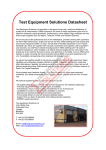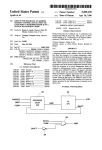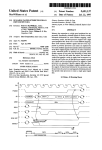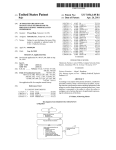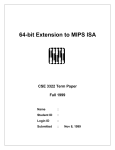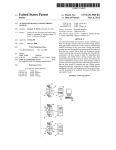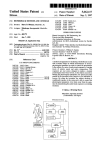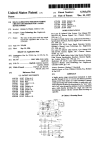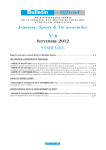Download Translation look-aside buffer including a single page size translation
Transcript
USOO5752275A
United States Patent [191
[11] Patent Number:
Hammond
[45]
Date of Patent:
[54] TRANSLATION LOOK-ASIDE BUFFER
Inventor:
May 12a 1998
FOREIGN PATENT DOCUMENTS
E PAGE SIZE
[75]
5,752,275
Gary N. Hammond, Campbell, Calif.
0113240 12/1983
European Pat. Off. .
1595740
5/1978
United Kingdom .
212
6/19 8 3 Um‘ted KiHgd0m .
OTHER PUBLICATIONS
7994
[73] Assignee: Intel Corporation, Santa Clara, Calif.
Kane, et al., “MIPS RISC Architecture”, Prentice Hall,
[21] APPL No; 893,085
Englewood Cli?s, New Jersey, Ch 6, 57 Pages, Ch 4, 30
.
Pages (1992).
[22] F?ed:
Jul‘ 14’ 1997
Pentium Processor User’s manual. Vol.3, Architecture and
Pr
112%;ammi ng Manual.IntlC
e orporation 1993 , PP .11—l—
Related U.S. Application Data
6
[ 3]
C t-m “-
[51] IntS.
[52]
f Se‘ N _ 414,206, M I 31’ 1995’ ab _
[1:11am °" °
6
r
°
................................
.
. .......................... .. 71 2
at
(1993), Mindshare Press, pp. 137 through 156.
“SPARC Reference MMU Architecture”, The SPARCTM
........ .. G20.6F1}21/;0
Architecture Mam] a1 Version 8’ Sun Microsystemsa Inc‘:
, 711/21 , 7
/
[58] Fleld of Search ................................... .. 7110271,l
[56]
References Cited
4,340,932
Tom Shanley and Don Anderson, ISA System Architecture
an
U.S. PATENT DOCUlVIENTS
7/1982
8
Dec_ 11, 1990’ pp_ 237_255.
“Chapter 6: Memory Achitectme, Paging”, The 80386
Book, Microsoft Press, Nelson, Ross P.. 1988, pp. 125-134.
“Chapter 5: Memory Management”, i486TM Processor Pro
grammer’s Reference Manual, Intel Corporation Literature
Sales, P.O. Box 7641, Mt. Prospect, Ill 60056-7641. 1990,
pp. 5-1 through 5-25.
(List continued on next page.)
Primary Examiner—Eddie P. Chan
‘£792,897 12/1988
Assistant Examiner-Reginald G. Bragdon
4,335,734
Attorney, Agent, or Firm—Blakely, SOkOlO?, Taylor &
511989
4,972,338 11/1990
4,979,098 12/1990
4,980,816 12/1990
Zafman
[57]
ABSTRACT
A method and apparatus for use in a computer system to
5:060:137 10/1991
5’179’674 1/1993
translate virtual addresses into translated addresses. Accord
ing to one aspect of the invention, a dynamically con?g
5,263,140 11/1993
urable translation unit is provided. Based on a value stored
5,278,963
5,412,737
5’413’975
in a storage area, the dynamically con?gurable translation
unit con?gures itself to support the single page size identi
?ed by the value. In one computer system, the dynamically
1/1994
5/1995
5/1995
8/199;
{175827
con?gurable translation unit is used in conjunction with a
multiple page size translation unit.
5:493,66O 2/1996
5,526,504
6/1996
20 Claims, 7 Drawing Sheets
r 1011
PREFERRED PAGE
,1,“
SIZETHANSLATION
UNIT
1B0
MULTIPLE PAGE
SIZ'ETFfxJfgATION
‘%
MEMORY MANAGEMENT UNIT 150
FTLB INSTALLATlON REGTSTEHS 160
TLB DEFAULT FEGISTEH 170
PRCEESSOB 110
_> NETWORK
125
5,752,275
Page 2
OTHER PUBLICATIONS
“i860TM XP Microprocessor”, i860 XP Microprocessor Data
Book. Intel Corporation Literature Sales, R0.Box 7641, Mt.
Prospect, 111 60056-7641, pp. 21-27, 1991.
“Chapter 3: Logical To Physical Address Translation”, Data
General MV 2000. pp. 32-37, (publication information
unknown).
“Chapter 4: Addressing”, i860TM Microprocessor Family
Programmer’s Reference Manual, Intel Corporation Litera
ture Sales, P.O. Box 7641,.Mt. Prospect, 111 650056-7641,
pp. 1-13, 1991.
“Computer Architecture A Quantative Approach,” Patterson,
David A. & Hennessey, John L.. Morgan Kaufman Publish
ers. Inc., San Mateo, California, pp. 432-485. 1990.
“Chapter 9, Case Study, The MIPS R2000”, Computer
Architeetrue Case Studies, Robert J. Barron & Lee Higbie,
1992, pp. 223 & 229.
US. Patent
May 12, 1998
Sheet 1 0f 7
5,752,275
r‘ 100
PREFERRED PAGE
1,40
SIZE TRANSLATION
uNIT
180
ST RA E
D VIC
I20
MULTIPLE PAGE
sIzE TRANSLATION
uNIT
ExEcuTION 0
UNIT 145
185
A
____
TLB155
KEYBOARD
‘30
MEMORY MANAGEMENT UN|T15O
FTLB INSTALLATION REGISTERS 160
*
DISQEAY
TT'?
FTLB DEFAULT REGISTER 170
175 I
j
PROCESSOR 11o
—-> NEEVgSORK
US. Patent
May 12, 1998
Sheet 2 of 7
THE OPERATING SYSTEM STORES A
VALUE IN A TLB DEFAULT REGISTER
IDENTIFYING THE CURRENTLY SELECTED
PREFERRED PAGE SIZE
I
THE PROCESSOR CONFIGURES THE PREFERRED
PAGE SIZE TRANSLATION UNIT
TO BE OPTIMIZED FOR THE CURRENTLY SELECTED
PREFERRED PAGE SIZE
220
5,752,275
US. Patent
May 12, 1998
Sheet 3 of 7
5,752,275
5
5
on
SmHEoadWsE
\22a65
(my@2 7;
US. Patent
May 12, 1998
Sheet 4 0f 7
5,752,275
REQUEST THE MEMORY MANAGEMENT UNIT TO
TRANSLATE A VIRTUAL ADDRESS INTO ITS
CORRESPONDING PHYSICAL ADDRESS
CHECK ALL ENTRIES IN THE
MULTIPLE PAGE SIZE
TRANSLATION UNIT
410
NO
YES
DETERMINE THE CORRESPONDING
PHYSICAL ADDRESS USING THE
MATCHING TRANSLATION
430
CHECK THE INDExED ENTRY IN
THE PREFERRED PAGE SIZE
TRANSLATION UNIT
440
YES
NO
STORE THE MATCHING
TRANSLATION IN THE
GENERATE A TLB MISS FAULT
4'
465
MULTIPLE PAGE SIZE
TRANSLATION UNIT
480
SERVICE THE TLB MISS FAULT
J
BY ExECUTING THE TLB MISS
-
HANDLER TO INSTALL THE
MISSING TRANSLATION 7
Egggg‘g’g???e
40
I
r
PHYSICAL ADDRESS
USING THE MATCHING
\
TRANSLATION
RESTART THE TLB MISS FAULT
CAUSING INSTRUCTION
485
\
Fig. 4
US. Patent
May 12, 1998
Sheet 5 0f 7
5,752,275
FROM
465
I
I
DETERMINE THE TRANSLATION
500
Y
STORE THE TRANSLATION IN THE
TLB INSTALLATION REGISTERS
510
INSTRUCT THE PROCESSOR TO
INSTALL THE TRANSLATION
540
INSTRUCT THE PROCESSOR TO
RESUME EXECUTION
550
470
TO 475
US. Patent
May 12, 1998
Sheet 6 of 7
5,752,275
FROM 510
IS THE TRANSLATION
A PREFERRED PAGE
SIZE TRANSLATION?
YES
STORE THE
TRANSLATION
IN THE
PREFERRED
NO
PAGE SIZE
TRANSLATION
UNIT
610
'1
Y
STORE THE TRANSLATION IN
THE MULTIPLE PAGE SIZE
TRANSLATION UNIT
540
TO 550
US. Patent
May 12, 1998
Sheet 7 of 7
5,752,275
wmo0S<iwm
mg
OS.
a
+
025 0
.52:
on“
mI0<o :23
owm
BM
wmE<w¢ :2:
Im<I :23
5,752,275
1
2
TRANSLATION LOOK-ASIDE BUFFER
INCLUDING A SINGLE PAGE SIZE
TRANSLATION UNIT
vided in Shanley, Tom and Anderson. Don. ISA System
Architecture, published by MindShare, Inc., 1993.
One method for implementing a memory management
unit is to hardwire the paging translation algorithm in the
processor. A second method for implementing a memory
This is a continuation of application Ser. No. 08/414,206.
?led Mar. 31, 1995, now abandoned.
management unit is to allow the paging translation algorithm
to be determined by the operating system (i.e.. a software
translation). According to this second method, if during the
BACKGROUND OF THE INVENTION
1. Field of the Invention
The invention relates to the ?eld of computer systems.
More speci?cally, the invention relates to the area of
memory management.
2. Background Information
Memory addressing schemes often use a technique called
paging to implement virtual memory. When using paging.
the virtual address space (i.e., the address space generated by
execution of a process a virtual address is generated whose
translation is not installed in the TLB, a TLB miss fault is
generated. In response to the TLB miss fault, the processor
interrupts the execution of the current process. stores the
interrupted process’ execution environment (i.e., the infor
mation necessary to resume execution of the interrupted
15
lation. Upon completion of the TLB handler. the processor
either the execution unit of a processor or by the execution
resumes execution of the interrupted process.
unit in conjunction with a segmentation unit of a processor)
is divided into ?x sized blocks called pages. each of which
can be mapped onto any of the physical addresses (i.e., the
addresses which correspond to hardware memory locations)
available on the system. In a typical computer system, a
memory management unit determines and maintains.
according to a paging algorithm, the current mappings for
the virtual to physical addresses using page tables. Upon
Some memory management units support multiple page
sizes-—i.e., the pages into which the virtual address space is
divided can be of different sizes. One commercially avail
able prooessor supports two page sizes by including a TLB
that has two parallel structures. One structure performs
25
processor checks both structures in parallel. Each of these
structures is implemented using a set associative cache (also
tual address into its corresponding physical address using
termed as set-indexed cache) hardwired on the processor. It
is well known that a set associative cache can have one or
more ways (also termed as banks). To determine if a
the page tables.
In one implementation, the page tables are accessed using
a page directory. Each virtual address includes three por
tions: a directory portion, a table portion, and an oifset
35
sor lack ?exibility in that they can each support only their
predetermined page size. As a result, the approach used in
11 page sizes.
In contrast. another commercially available processor
supports multiple page sizes using a TLB containing a fully
associative cache. By using a fully associative cache, this
processor supports multiple page sizes using a single struc
of the appropriate page-table entry by adding the table
portion (from the virtual address) to the page-table-base
address (from the directory entry). Each page-table entry
ture. However, to determine if a translation for a virtual
45
by adding the o?set portion (from the virtual address) to the
page-frame-base address (from the page-table entry).
Since the page tables are in main memory, accessing them
address is stored in a fully associative cache, each entry in
the fully associative cache must be checked. As a result, a
fully associative cache has a lower density (i.e., can store
less translations) than a set associative cache of the same
size due to the extra circuitry required to check, in parallel,
every entry in the cache.
is time consuming. To speed up the paging translations,
certain of the translations are stored in a translation look
aside bu?er or TLB (a faster memory which is preferably
located on the processor). Upon generating a virtual address
requiring translation, the memory management unit ?rst
searches for the translation in the TLB before accessing the
paging algorithm and page tables.
translation for a virtual address is stored in a set associative
cache. only one entry per way needs to be checked. The set
associative caches used for the TLB in this prior art proces
this processor requires a ‘TLB having n parallel structures for
get the address of the appropriate directory entry. Each
directory entry stores the base-address of a page table, which
is also held in main memory. The processor ?nds the address
stores the base-address of a page-frame. Finally, the proces
sor ?nds the virtual address’ corresponding physical address
translations for one page size. while the other structure
performs translations for the other page size. To determine
if a translation for a virtual address in stored in the TLB, the
receiving a virtual address from the execution unit of a
processor. the memory management unit translates the vir
portion. The directory portion is an offset into the page
directory, which is held in main memory. The base-address
of this page directory is held in a control register. The
processor adds the base-address to the directory portion to
process). and invokes an operating system handler (referred
to herein as the TLB handler) to perform the paging trans
SUMIVIARY
A method and apparatus for use in a computer system to
translate virtual addresses into translated addresses. Accord
55
ing to one aspect of the invention. a dynamically con?g
Each translation stored in the TLB contains a virtual
urable translation unit is provided. Based on a value stored
address portion and a physical address portion. To determine
in a storage area, the dynamically con?gurable translation
unit con?gures itself to support the single page size identi
?ed by the value. According to another aspect of the
invention, a computer system contains both the dynamically
if a translation corresponds to a virtual address, the directory
and table portions of the virtual address are compared to the
virtual address portion of the translation. If they do not
match, the translation does not correspond to the virtual
address. However, if they match, the translation corresponds
to the virtual address. If the translation corresponds to the
virtual address, the physical address portion of the transla
tion is concatenated with the o?rset portion of the virtual
address to generate the virtual address’ corresponding physi
cal address. Further explanation of paging schemes is pro
con?gurable translation unit and a multiple page size trans
lation unit.
According to another aspect of the invention. the dynami
cally con?gurable translation unit includes a selector unit
65 that selects an appropriate part of a virtual address based on
the single page size being supported. The selected part of the
virtual address is used to index an entry in a cache unit. The
5,752,275
3
4
indexed entry in the cache unit is used to store a translation.
described with reference to one-way caches so as not to
The dynamically con?gurable translation unit also includes
obscure the invention. However, alternative embodiments
could be implemented to include multiple-way associative
a comparing unit that also selects a second part of the virtual
caches.
address based on the single page size being supported. The
comparing unit compares the second part of the virtual
address with the translation found in the indexed entry to
Overview
determine if there is a translation hit. If there is a translation
In one embodiment, the TLB includes two structures: a
hit. the combining unit combines the appropriate parts of the
preferred page size translation unit and a multiple page size
translation unit. The multiple page size translation unit
includes a fully associative cache which is implemented to
allow each entry in the cache to be checked in parallel—-e.g.,
to allow the virtual address portion and page size of each
translation in the cache to be checked in parallel. Using this
cache, the multiple page size translation unit stores transla
tions for the di?erent page sizes supported by the processor.
translation and virtual address to generated a location in a
translated address space.
10
According to yet another aspect of the invention. a
translation look-aside buffer in a computer system includes
a set associative cache and a fully associated cache. The set
associative cache is used for storing address translations for
a single page size, while the fully associative cache is used
for simultaneously storing address translation for multiple
In contrast, the preferred page size translation unit acts as a
set associative cache which supports a selected one (referred
page sizes. In one embodiment of this computer system. the
set associative cache is part of a dynamically con?gurable‘
translation unit
According to yet another aspect of the invention, a
translation look-aside buffer in a computer system includes
two separate translation units for respectively storing trans
lations for multiple pages sizes and a single page size. In
addition, the second translation unit stores the virtual to
physical address translations for the single page size in a
storage device coupled to the processor.
to herein as the “preferred page size”) of the multiple page
sizes supported by the processor. Since the preferred page
size translation unit acts as a set associative cache, it has a
higher capacity than fully associative caches. The preferred
page size translation unit may be implemented using
hardware, microcode, and/or software and may be imple
25
page size of the multiple page sizes supported by the
processor is selected as the preferred page size. By using the
BRIEF DESCRIPTION OF THE DRAWINGS
combination of a fully associative cache and a set associa
tive cache, the invention can provide a higher density than
either a TLB having parallel set associative caches (one for
each page size) or a TLB having only a fully associative
cache.
The invention may best be understood by referring to the
following description and accompanying drawings which
illustrate the invention. In the drawings:
FIG. 1 is a block diagam illustrating an exemplary
computer system 100 incorporating the teachings of the
invention;
Additionally, the preferred page size translation unit is
35
FIG. 2 illustrates a ?ow diagram for the selection of the
preferred page size according to one embodiment of the
16K page size;
FIG. 4 illustrates a ?ow diagram of the steps performed by
45
FIG. 6 illustrates a ?ow diagram further describing step 50
540 of FIG. 6; and
FIG. 7 illustrates an alternative embodiment of the inven
page sizes (e.g., 4M, 16M, 256M). In one implementation,
implemented in software.
55
instances, well-known circuits, structures and techniques
have not been shown in detail in order not to unnecessarily
obscure the invention. For example, the invention will be
selecting the appropriate page size to optimize the operation
of their operating system and other software.
Research shows that execution of typical operating sys
tem routines and applications is optimized using a single,
smaller page size (e.g., 4K 8K, 16K, etc.), while functions
such as frame buifers and 110 are optimized using larger
tion in which the preferred page size translation unit is
details are set forth to provide a thorough understanding of
the invention. However, it is understood that the invention
may be practiced without these speci?c details. In other
selected preferred page size to a different page size to
optimize the performance of different applications. In this
manner, software developers are allowed the ?exibility of
performed in step 470 of FIG. 4 (i.e., the steps performed by
the TLB handler);
translation). In the following description, numerous speci?c
selected by the operating system—e.g.. the preferred page
size translation unit is dynamically configurable to support
selects the preferred page size by setting bits in a TLB
default register. As later described, the preferred page size
translation unit then con?gures itself such that it supports the
selected page size. In addition, during operation of the
computer system, the operating system can ?ush the pre
ferred page size translation unit and change the currently
FIG. 3 illustrates one embodiment of the preferred page
size translation unit of FIG. 2 which supports a 4K, 8K and
DETAILED DESCRIPTION
A method and apparatus for translating virtual addresses
into physical addresses are described which provide for
multiple page sizes, while having a high density and a low
look-up penalty (i.e., the time required to determine a
implemented such that the page size it supports can be
any one of a number of page sizes. The operating system
invention;
processor 110 upon a request to the memory management
unit to translate a virtual address into its corresponding
physical address according to on embodiment;
FIG. 5 illustrates a more detailed description of the steps
mented to cache the translations in a storage area on the
processor or oil’ the processor. Typically, the most common
the operating system sets the preferred page size to be a
small page size (e.g., 4K, 16K etc.) and executes itself and
other applications using this page size. However, the oper
ating system uses other larger page sizes for frame buffers,
I/O, etc.
.
One Embodiment of the Invention
FIG. 1 is a block diagram illustrating an exemplary
computer system 100 incorporating the teachings of the
invention. The exemplary computer system includes a pro
65 cessor 110, a storage device 120, a network 125, and a bus
140. Processor 110 is coupled to storage device 120 and
network 125 by bus 140. In addition, a number of user
5,752,275
5
6
input/output devices, such as a keyboard 130 and a display
135, are also coupled to bus 140. Processor 110 represents
a central processing unit of any type of architecture, includ
ing a CISC or RISC type architecture. Storage device 120
embodiments could be implemented which do not include
preferred page size translation unit 180. Such an alternative
embodiment would include TLB default register 170 to
maintain compatibility. but would not take the “hint” pro
represents one or more mechanisms for storing data. For
vided by the operating system in preferred page size indi
cation 175 because the necessary circuitry is not provided.
example, storage device 120 may include read only memory
(ROM), random access memory (RAM), magnetic disk
storage mediums, optical storage mediums, and/or ?ash
memory devices. While one embodiment will be described
in which the invention is implemented in a single processor
computer system, the invention could be implemented in a
10
TLB installation registers 160 are used for installing
translations in TLB 155. To install a translation in TLB 155,
multi-processor computer system.
the TLB handler executing on processor 110 stores the
FIG. 1 also illustrates that processor 110 includes an
translation in TLB installation registers 160 and issues a
execution unit 145. a memory management unit 150, TLB
command requesting processor 110 to install the translation
installation registers 160. and aTLB default register 170. Of 15
in
TLB 155. In response to this command, processor 110
course, processor 110 contains additional circuitry which is
preferably stores the translation contained in TLB installa
not shown so as to not obscure the invention.
TLB default register 170 is used for storing information
concerning the operation of memory management unit 150.
tion registers 160 in both preferred page size translation unit
180 and multiple page size translation unit 185. While this
TLB default register 170 includes a number of bits which
make up a preferred page size indication 175. In one
embodiment will be described in relation to a single TLB.
embodiment, an operating system executing on computer
a second TLB for data. TLB installation registers 160
system 100 stores preferred page size indication 175 as a
preferably includes three registers: 1) a ?rst register for
storing the virtual address portion of a translation; 2) a
second register for storing the physical address portion of a
translation; and 3) a third register for storing control
“hint” to indicate which of the multiple page sizes should be
selected as the preferred page size. As described, processor
110 supports a 4K page size, an 8K page size, and a 16K
page size. However, alternative embodiments could support
more, less, and/or different page sizes (e.g.. an alternative
embodiment could include a 4M page size). While the
indication identifying the preferred page size is described as
a number of bits, alternative embodiments could store this
alternative embodiments could use a ?rst TLB for a code and
25
information, such as the translation’s page size.
FIG. 2 illustrates a ?ow diagram for the selection of the
preferred page size according to one embodiment of the
indication any number of ways, (e.g., otf chip, hardwired,
and/or using a single bit).
invention. As shown in step 210, the operating system
Memory management unit 150 includes a TLB 155 and
supports the mapping of virtual memory addresses to physi
35
executing on processor 110 stores a value identifying the
current preferred page size in a TLB default register and
?ow passes to step 220. To provide an example, assume the
cal memory addresses using a software TLB handler (not
shown). While one embodiment is described in which
memory management unit 150 utilizes a software translation
TLB default register 170 to identify the 4K page size as the
algorithm, alternative embodiments could implement the
currently preferred page size.
memory management unit in any number of ways, including
a hardwired paging translation circuit.
TLB 155 is used for speeding up the translation of virtual
memory addresses into translated memory addresses. While
these translated memory addresses are described herein as
physical memory addresses, in alternative embodiments
operating system alters preferred page size indication 175 in
At step 220, the processor con?gures the preferred page
size translation unit to be optimized for the preferred page
size and ?ow passes to step 230. In the present example,
processor 110 con?gures the preferred page size translation
unit 180_to support a 4K page size.
these translated memory addresses could be used for any
number of purposes. For example, further translations could
be performed on these translated memory addresses before
physical addresses are achieved. In addition, while one
FIG. 3 shows one embodiment of the preferred page size
embodiment is described in relation to translating a virtual 50 translation unit of FIG. 2 which supports a 4K, 8K and 16K
memory address space, alternative embodiments could use
page size. Below, Table 1 illustrates the bit locations used for
the invention to assist in the translation of any type of
a virtual page number portion and an offset portion of a
addresses. TLB 155 includes a preferred page size transla
32-bit
virtual address for the 4K, 8K, and 16K page size.
tion unit 180 and a multiple page size translation unit 185.
While one embodiment is described which uses 32 address
Preferred page size translation unit 180 dynamically con 55
ing bits, alternative embodiments could use any number of
?gures to support the page size indicated by preferred page
size indication 175. For example, if preferred page size
indication 175 was altered by the operating system to
indicate a 4K page size, preferred page size translation unit
180 would con?gure itself to support a 4K page size.
Preferred page size translation unit 180 will be further
described with reference to FIGS. 2, 3 and 7. Multiple page
size translation unit 185 is preferably implemented using a
fully associative cache which allows each entry in the cache
to be checked in parallel.
65
While one embodiment has been described which con
tains preferred page size translation unit 180, alternative
addressing bits (e.g., 64 addressing bits). The use of the
virtual page number portion is determined by the TLB
handler. For example, the TLB handler can be implemented
to maintain a single page table or to maintain both a
directory and a set of page tables. Table 1 also illustrates the
masks which are used for the 4K, 8K, and 16K page sizes to
select either the offset portion or the virtual page number
portion of the virtual address requiring translation. As an
example, if a 4K page size is being used, ANDing the mask
“00 00 0F FF” with a virtual address will generate the offset
portion of that virtual address.
5,752,275
PAGE
SEE
8
TABLE 1
into this shift register. The output of this shift register is
coupled to preferred page size cache 340.
Preferred page size cache 340 is a set associative cache
VIRTUAL ADDRESSES
31
4K
7
12 11
storing in each entry a translation. Each translation includes
a virtual address portion and a physical address portion. In
addition, each translation preferably includes a control infor
mation portion. Preferred page size cache 340 has an input
coupled to line 330, as well as two outputs coupled to lines
MASK
0
Virtual Page Number w
00 00 OF FF
342 and 344. respectively. Lines 342 and 344 each represent
31
8K
0
Virtual Page Number M
31
16K
13 12
14 13
32 address lines. In response to receiving an index on line
330, preferred page size cache 340 selects the entry corre
sponding to that index. The virtual address and the physical
address portions of the translation stored in that entry are
asserted on the address lines represented by line 342 and line
00 00 1F FF
0
Virtual Page Number w
344, respectively. The address lines represented by line 342
00 00 3F 00
15
are coupled to the inputs of a comparator 382, while the
address lines represented by line 344 are each coupled to the
input of a corresponding one of 32 OR gates represented by
OR gate 390.
FIG. 3 also shows a multiplexor 350. which is used for
The embodiment shown in FIG. 3 includes a cache that
can store 256 entries. As a result, 8 address bits are required 20 selecting the appropriate mask for the currently selected
to access the entries of this cache. However. alternative
page size. A line 352, a line 354, and a line 356 are each
coupled as the inputs into multiplexor 350. Lines 352, 354
embodiments could use a different size cache requiring a
diiferent number of addressing bits.
and 356 each represent 32 address lines on which the 4K
mask, the 8K mask, and the 16K mask from Table 1 are
FIG. 3 shows a node 305 representing 32 address lines for
respectively asserted Multiplexor 350 has a control input
for receiving the signal identifying the preferred page size.
Based on this control signal. multiplexor 350 transmits at its
receiving a 32 bit virtual address. The 32 lines represented
by node 305 are coupled to a node 310. At node 310, the 32
address lines are split and/or spliced into three sets of
address lines represented by line 312, line 314, and line 316.
Each of lines 312, 314, and 316 carry the address bits used
as an index into the cache for the 4K, 8K and 16K page size,
output (a set of 32 address lines) the mask asserted on one
of the sets of address lines represented by lines 352, 354, and
30
the currently selected preferred page size ‘is chosen. For
example, if the 4K page size was selected, the output of
multiplexor 350 would be “00 00 0F FF”.
Each of the 32 address lines transmitting the output of
respectively. Line 312 represents the address lines contain
ing bits 19 through 12 of a virtual address asserted at node
305 (i.e., the eight bits following the offset portion of the
virtual address for the 4K page size). Line 314 represents the
address lines containing bits 20 through 13 of the virtual
address asserted at node 305 (i.e., the eight bits following the
o?’set portion of the virtual address for the 8K page size).
Line 316 represents the address lines containing bits 21
through 14 of virtual address asserted at node 305 (i.e., the
eight bits following the offset portion of the virtual address
for the 16K page size). Line 312, line 314, and line 316 are
each coupled as the inputs into a multiplexor 320. While one
35
these inverters represents the logical inversion of the mask
for the currently selected page size. For example, if the 4K
page size was selected, the output of these inverters would
be “FF FF F0 00”. ‘The output of each inverter represented
by inverter 360 is coupled to the ?rst input of a correspond
ing one of 32 AND gates represented by AND gate 380. The
second input of each of the AND gates represented by AND
gate 380 is coupled to a corresponding one of the address
lines represented by line 307, such that the address lines
Multiplexer 320 has a single output of 8 address lines
represented by line 330. Multiplexor 320 also has a control
input for receiving a control signal identifying the currently
selected preferred page size. Based on this control signal,
multiplexor 320 selects the bits asserted on one of the sets 50
of address lines represented by lines 312, 314, and 316 to be
transmitted on output line 330. In this manner, the bits of a
virtual address asserted at node 305 to be used as the index
into a preferred page size cache 340 are selected based upon
55
340) into this shift register based on the previously described
control signal identifying the currently selected preferred
page size. For example, if the 16K page size is the currently
selected preferred page size, VA[21:14] would be shifted
gates would be “11100011 10001110 00110000 00000000”.
The output of the AND gates represented by AND gate
380 and the address lines represented by line 342 are
coupled to inputs of comparator 382. Comparator 382 com
virtual address asserted at node 305) and the signal asserted
on the address lines represented by line 342 (i.e., the virtual
cuitry. For example, one alternative embodiment uses an
address to be used as the index into preferred page size cache
carrying the same bit locations in the virtual address asserted
at node 305 and the selected mask are ANDed together. In
this manner, the o?iset portion of the virtual address asserted
at node 305 is masked out. Thus, in the present example, if
the virural address asserted at node 305 was “11100011
10001110 00111000 11100011”, the output from these AND
pares the signals outputted from the AND gates represented
by AND gate 380 (i.e., the virtual page number portion of the
While circuitry for selecting the address bits to be used as
the index into preferred page size cache 340 has been
described, alternative embodiments could use different cir
8-bit shift register in place of multiplexor 320. In this
embodiment, circuitry is included which shifts the appro
priate bits of the virtual address (i.e., the bits of the virtual
multiplexor 350 is coupled to a corresponding one of the 32
inverters represented by inverter 360. Thus, the output of
embodiment is described in which certain address bits are
used to form the index into the cache, alternative embodi
ments could use different bits of the virtual address.
the currently selected preferred page size.
356. In this manner, the mask to be used in conjunction with
60
address portion of the translation). Ifthese signals match, the
indexed translation corresponds to the virtual address
asserted at node 305 and comparator 382 transmits to a node
384 a signal indicating such—i.e., a TLB hit. In contrast, if
these signals do not match, comparator 382 transmits to
node 384 a signal indicating the translation for the virtual
address asserted at node 305 is not contained in the preferred
page size cache 340—i.e., a TLB miss.
5,752,275
10
Each of the address lines which carry the output from
multiplexor 350 are also coupled to a corresponding one of
size translation unit corresponds to the virtual address
requiring translation. If a match was found, ?ow passes to
32 AND gates represented by AND gate 370. The other input
step 480. Otherwise, ?ow passes to step 465.
As shown in step 480, the matching translation is stored
in the multiple page size translation unit and ?ow passes to
step 485. Thus, in one embodiment. preferred page size
of each'of these AND gates is coupled to a corresponding
one of the address lines represented by line 307, such that
corresponding bit locations in the virtual address asserted at
node 305 and the currently selected mask are ANDed
translation unit 180 is used as a second layer or level of the
together. Thus, the output of these AND gates is the offset
TLB. That is, when a miss is detected in the multiple page
size translation unit 185, the processor inspects the preferred
portion of the virtual address asserted at node 305. For
example, if the 4K page size is the currently selected page
size and the virtual address asserted at node 305 is
“11100011 10001110 00111000 1110001”, the output from
these AND gates is “00000000 00000000 00001000
1110001”. The output of each of the AND gates represented
by AND gate 370 is coupled to the other input of a
corresponding one of the 32 OR gates represented by OR
gate 390. The outputs of the OR gates represented by OR
gate 390 are coupled to the 32 address lines represented by
node 395. Thus, these OR gates receive the physical address
portion of the translation and the offset portion of the virtual
page size translation unit for the translation. If the preferred
page size translation unit contains the translation, it is copied
into the multiple page size translation unit 185. This is
advantageous because, as previously described, the multiple
15
At step 485, the corresponding physical address is deter
mined using the matching translation.
If a matching translation for the virtual address is not
found in step 450, step 465 is performed. As shown in step
20
address asserted at node 305. As a result. the output of these
OR gates is a physical address—i.e., the physical address
portion of the translation concatenated with the o?set por
tion of the virtual address asserted at node 305.
The physical address asserted at node 395 is the physical
address corresponding to the virtual address asserted at node
25
305 if the virtual address asserted on the address lines
such that if the signal asserted at node 384 indicates the
translation is stored in preferred page size cache 340 (i.e., a
TLB hit), the physical address asserted at node 395 will be
dynamically con?gures to support the page size identi?ed by
the control signal received at the control input of both
multiplexor 320 and multiplexor 350. In this manner, this
preferred page size translation unit provides high density. In
addition, this preferred page size translation unit offers the
?exibility of allowing the processor to select the most
advantageous page size.
FIG. 4 shows a ?ow diagram of the steps performed by
465, a TLB miss fault is generated and ?ow passes to step
470. This TLB miss fault is generated and serviced by the
event handling mechanism of processor 110. Event handling
mechanisms are well known in the art
represented by line 342 corresponds to the virtual address
asserted at node 305. Therefore, circuit 300 is implemented
the address corresponding to the virtual address asserted at
node 305.
Thus, the circuit described with reference to FIG. 3
page size translation unit has a lower capacity for transla
tions than the preferred page size translation unit.
As shown in step 470. the TLB miss fault is serviced by
executing the TLB miss handler to install the translation for
the virtual address. ‘This step will be further described with
reference to FIG. 5. From step 470, ?ow passes to step 475.
As shown in step 475, processor 110 resumes execution of
the interrupted process at the TLB miss fault causing instruc
tion (i.e., the instruction which generated the virtual address
described in step 400). In so doing, the same virtual address
described in step 400 will again be generated and the
memory management unit will again be requested to trans
late the virtual address. However, this time the translation
35
will be stored in at least one of preferred page size transla
tion unit 180 and multiple page size translation unit 185. As
a result, ?ow will pass through the ?ow diagram and
terminate in one of steps 430 and 485 in which the corre
sponding physical address is determined for the virtual
address.
FIG. 5 shows a more detailed description of the steps
performedin step 470 of FIG. 4 (i.e., the steps performed by
the TLB handler). From step 465, in which aTLB miss fault
is generated, ?ow passes to step 500.
processor 110 upon a request to the memory management
unit to translate a virtual address into its corresponding 45
As shown in step 500. the translation for the virtual
physical address according to one embodiment of the inven
address is determined and ?ow passes to step 510. Methods
tion. Starting at step 400, a request is sent to the memory
for performing this determination are well known in the art,
management unit to translate a virtual address into its
and thus, are not further described here so as not to obscure
corresponding physical address. From step 400, ?ow passes
the invention.
50
to step 410.
As shown in step 510, the translation is stored in the TLB
As shown in step 410, the entries in the multiple page size
installation registers and ?ow passes to step 540.
translation unit are inspected to determine if they contain the
As shown in step 540, the TLB handler instructs the
translation for the virtual address. From step 410, ?ow
processor to install the translation and ?ow passes to step
passes to step 420.
55 550. In response to receiving this instruction, the processor
As shown in step 420, it is determined whether a match
installs the translation in one or both of the translation units.
was found for the virtual address. If a match was found, ?ow
This step will be further described with reference to FIG._6.
passes to step 430. Otherwise, ?ow passes to step 440.
As shown in step 550, the TLB handler instructs the
At step ‘430, the virtual address’ corresponding physical
processor to resume execution of the process interrupted for
address is determined using the matching translation found
the servicing of the TLB miss fault. From step 540, ?ow
in the multiple page size translation unit 185.
passes to step 475.
As shown in step 440, the translation stored in the indexed
FIG. 6 shows a ?ow diagram further describing step 540
entry of the preferred page size translation unit identi?ed by
of FIG. 5. Flow passes from step 510, in which the trans
the virtual address is inspected. From step 440, ?ow passes
lation for the virtual address is stored in the TLB installation
to step 450.
registers, to step 600.
As shown in step 450. it is determined whether the
At step 600, it is determined whether the translation is of
translation stored in the indexed entry of the preferred page
the preferred page size. If the translation is of the preferred
5,752,275
11
12
page size, flow passes to step 610. Otherwise ?ow passes to
step 620. Determining whether the translation is of the
preferred page size is a software convention. For example,
an operating system could be implemented such that the
directory portion of a virtual address identi?es which page
size the virtual address is located on. Thus, by inspecting the
directory portion of the virtual address, it can be determined
whether the virtual address is of the preferred page size.
While one embodiment is described in which the directory
portion of the virtual address is used to determine the page
size of the virtual address. alternative embodiments could be
implemented to make this determination in any number of
ways.
As shown in step 610. the translation is stored in the
preferred page size translation unit and ?ow passes to step
620.
As shown in step 620, the translation is stored in the
multiple page size translation unit. From step 620, ?ow
passes to step 550. Thus, if the translation is for the preferred
page, the translation is installed in both preferred page size
translation unit 180 and multiple page size translation unit
185. However, if the translation is for other than the pre
would be called as a handler in response to an interrupt. Such
an interrupt would occur at step 440 of FIG. 4. Preferred
page size translation unit 700 includes a hash unit 720, a
cache unit 730, a comparing unit 740, a combining unit 745
and a preferred page size unit 750. Preferred page size unit
750 stores an indication identifying which of the page sizes
supported by processor 110 is currently selected as the
preferred page size. Thus, preferred page size unit 750 acts
as preferred page size indication 175.
FIG. 7 shows that preferred page size translation unit 700
15
receives virtual addresses 710 into a hash unit 720. Hash unit
720 represents a hash algorithm which acts in a similar
fashion to multiplexor 320. Hash unit 720 selects the appro
priate portion of virtual addresses 710 to be used as an index
into cache unit 730. Hash unit 720 determines which hit
locations of virtual addresses 710 to select based upon the
input received from preferred page size unit 750 which
indicates the currently selected preferred page size.
Cache unit 730 is a software cache whose entries contain
preferred page size translations. These entries are stored
starting at a base address such that they may be indexed by
a portion of a virtual address according to the algorithm
implemented in hash unit 720. Upon receiving the index
ferred page size, the translation is only stored in multiple
from hash unit 720, the virtual address and physical address
page size translation unit 185. While one embodiment is
25 portions of the translation stored at the entry identi?ed by
described in which such translations are stored in both the
hash unit 720 are transmitted to comparing unit 740 and
preferred page size translation unit and the multiple page
combining unit 745, respectively.
size translation unit, alternative embodiments could be
implemented to install translations corresponding to the
Comparing unit 740 also receives data from preferred
page size unit 750 identifying the currently selected pre
preferred page size in only one of these translation units.
Again, this translation is stored in both translation units,
because preferred page size translation unit 180 is acting as
a level two portion of TLB 155.
ferred page size. Comparing unit 740 acts in a similar
fashion to multiplexor 350, inverter 360, AND gate 380, and
comparator 382. Thus, comparing unit 740 determines
whether the translation received from cache unit 730 corre
An Alternative Embodiment of the Invention
35
In an alternative embodiment, preferred page size cache
340 is replaced with a cache that is implemented to store the
sponds to the virtual address currently being translated
Comparing unit 740 indicates to combining unit 745
whether a matching translation was found.
embodiment, this cache uses the output of multiplexor 320
Combining unit 745 also receives data from preferred
page size unit 750 identifying the currently selected pre
as a hash into this data structure—e.g., the translations are
ferred page size. Combining unit 745 acts in a similar
stored starting at a base address and the cache concatenates
the output of multiplexor 320 with this base address to form
fashion to multiplexor 350, AND gate 370, and OR gate 390.
Thus, if the identi?ed translation does correspond to the
the address of an entry in this data structure. This cache
virtual address currently being translated, comparing unit
retrieves from the data structure, the virtual address portion
and the physical address portion of the translation identi?ed
by the index and transmits these values on the address lines
physical address portion of the identified translation and
transmits the resulting physical address to physical address
translations in a data structure in storage device 120. In one
740 also combines the offset of that virtual address with the
45
represented by line 342 and 344, respectively. The starting
high speed of operation, while the software portion allows
760. In one embodiment, these physical addresses are stored
in TLB installation registers 160 and the processor is
instructed to install them in multiple page size translation
unit 185.
However, if a matching translation was not found, com
bining unit 745 communicates as such. In one embodiment,
for a large number of entries to be stored. In this manner, the
the processor responds to this communication using the
address of this data structure could be hardwired into
processor 110 or stored in a prede?ned register by the
operating system.
50
The hardwired portion of this embodiment allows for a
event handling mechanism to cause the execution of a
size translation unit is not limited by the die area on the 55 multiple page size TLB handler. Of course alternate embodi
ments could handle this communication in any number of
processor. In addition, using the event handling mechanism
number of entries which may be stored in the preferred page
ways, for example preferred page size translation unit 700
has a longer look-up penalty than this embodiment. As a
result, this embodiment reduces the look-up penalty for a
larger number of the most commonly accessed translations
as compared to using the software TLB handler.
could call a multiple page size TLB routine itself.
Since preferred page size translation unit 700 only per
forms translations for the currently selected preferred page
Another Alternative Embodiment of the Invention
In another alternative embodiment of the invention, the
preferred page size translation unit is implemented in soft
ware using software caching. One embodiment of such an
implementation is illustrated in FIG. 7 as preferred page size
translation unit 700. Preferred page size translation unit 700
65
size, it has a lower look-up penalty than a software TLB
handler which performs translations for all page sizes. While
this embodiment has been described in which each of the
units comprising preferred page size translation unit 700 are
implemented in software, alternative embodiments could
implement one or more of the units comprising preferred
page translation unit 700 in circuitry.
5,752,275
13
14
Alternative Embodiments
11. The apparatus of claim 10 further comprising:
a storage area to store a dynamic value identifying the
While the invention has been described in terms of several
embodiments, those skilled in the art will recognize that the
invention is not limited to the embodiments described The
5
method and apparatus of the invention can be practiced with
modi?cation and alteration within the spirit and scope of the
appended claims. The description is thus to be regarded as
illustrative instead of limiting on the invention.
What is claimed is:
1. A translation look-aside bu?ier comprising:
13. A computer system comprising:
a processor;
a ?rst storage area to store a dynamic value identifying a
single page size;
a ?rst translation unit to simultaneously store virtual to 15
physical address translations for a plurality of page
address translations for only the single page size iden
ti?ed by said dynamic value.
said translation look-aside buffer.
14. The computer system of claim 13 further comprising:
2. The translation look-aside buffer of claim 1, wherein
said second translation unit comprises a set associative
cache.
3. The translation look-aside bu?’er of claim 1, wherein
said second translation unit is implemented in software.
4. The translation look-aside buffer of claim 3, wherein
said ?rst translation unit comprises a fully associate cache.
a storage area to store a dynamic value identifying the
single page size, said second translation unit coupled to
said storage area and being responsive to support the
single page size identi?ed by said dynamic value.
15. The translation look-aside buffer of claim 13, wherein
said ?rst translation unit comprises a fully associate cache.
16. The translation look-aside buifer of claim 13, wherein
said plurality of page sizes includes said single page size.
5. A computer system comprising:
an execution unit generating a ?rst virtual address and a
30
a ?rst storage area having stored therein a dynamic value
identifying one of a ?rst page size and a second page
size;
a ?rst translation unit having stored therein a ?rst trans 35
lation and a second translation, said ?rst translation for
translating said ?rst virtual address into a ?rst trans
lated address identifying a ?rst location in a ?rst page
translated address identifying a second location in a
a second translation unit to store virtual to physical
said storage device; and
a TLB miss handler, in said storage device, coupled to
a second translation unit to store virtual to physical
of said ?rst page size, said second translation for
translating said second virtual address into a second
a storage device coupled to said processor;
a translation look-aside butfer comprising:
a ?rst translation unit, in said processor, to simulta
neously store virtual to physical address translations
for a plurality of page sizes. and
address translations for only a single page size in
sizes; and
second virtual address;
single page size, said second translation unit coupled to
said storage area and being responsive to support the
single page size identi?ed by said dynamic value.
12. The apparatus of claim 10, wherein said plurality of
page sizes includes said single page size.
17. A method for translating a virtual address into a
physical address, said method comprising the computer
implemented steps of:
con?guring a ?rst translationunit to provide virtual to
physical address translations for a single page size;
determining if a translation for said virtual address is
stored in said ?rst translation unit or a second transla
tion unit, said second translation unit providing virtual
to physical address translations for multiple page sizes;
if said translation is not in either said ?rst translation unit
or said second translation unit, then executing a trans
second page of said second page size; and
lation look-aside butfer miss handler; and
a second translation unit dynamically con?gured to trans
translating said virtual address into said physical address
late only one of said ?rst virtual address and said
using said translation.
second virtual address based on said dynamic value. 45
18. The method of claim 17, wherein said step of deter
6. The computer system of claim 5, said second transla
mining if a translation for said virtual address is stored in
tion unit comprising a dynamically con?gurable set asso
said ?rst translation unit or said second translation unit
ciative cache.
further comprises the step of:
7. The computer system of claim 6, wherein said second
searching for said translation in a table stored in a storage
translation unit is implemented in software.
device coupled to a processor to determine if said
8. The computer system of claim 5, said ?rst translation
translation is stored in said ?rst translation unit.
unit comprising a fully associative cache.
19. The method of claim 17, wherein said step of deter
9. The computer system of claim 5, wherein said ?rst
mining if a translation for said virtual address is stored in
translated address and said second translated address are
physical addresses.
10. An apparatus for use in a computer system compris
ing:
an execution unit to generate virtual addresses;
a ?rst translation unit, coupled to said execution unit,
including a fully associative cache to simultaneously
store address translations for a plurality of page sizes;
and
a second translation unit, coupled to said execution unit,
including a set associative cache to store address trans
lations for a single page size.
said ?rst translation unit or said second translation unit
further comprises the step of:
searching for said translation in said ?rst translation unit;
and
searching for said translation in said second translation
unit only if said translation is not found in said ?rst
translation unit.
20. The method of claim 17 further including the step of:
installing translations for the single page size in both the
?rst and second translation.
*
*
*
*
*
















